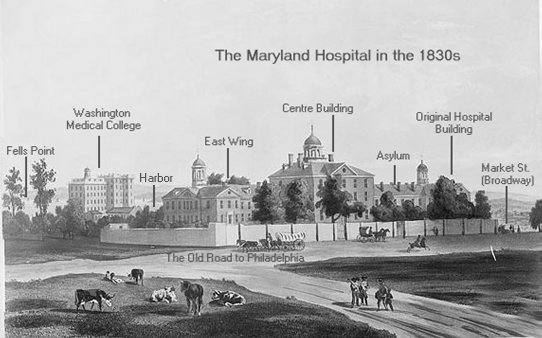Lithograph of the Maryland Hospital
 This lithograph of the Maryland Hospital (today known as Spring Grove Hospital Center), in its Baltimore City location, was published in 1847. However, it was almost certainly drawn sometime between 1827 and 1836.* The view is to the southwest. The portion of the structure shown at the far right of the picture (west), barely visible behind the trees, was the original building, c.1798. The other sections of the hospital (i.e., the balance of the West Wing, the "Centre Building," and the entire East Wing) were added between 1808 and 1819. The Street shown in the foreground is in the location of today's Wolfe Street. (Eventually, Wolfe Street ran in a north-south direction, immediately beyond the Hospital's eastern wall.) The street that runs in front of the wall in the image was the Old Joppa Road. This byway, also known as "the Old Road to Philadelphia," from Philadelphia, through Baltimore, to Annapolis. It was later abandoned and its roadbed eventually became part of the hospital's property. Market Street (not shown -- now Broadway) would be off to the right (west) of the hospital in this picture. In the background, to the far left, would have been Fells Point. The Baltimore Harbor would have been in the background behind the East Wing. The four-story building shown behind the Maryland Hospital was the Washington Medical College (1827 - 1877) and its associated hospital, which was then known known as the Washington Hill Hospital.
This lithograph of the Maryland Hospital (today known as Spring Grove Hospital Center), in its Baltimore City location, was published in 1847. However, it was almost certainly drawn sometime between 1827 and 1836.* The view is to the southwest. The portion of the structure shown at the far right of the picture (west), barely visible behind the trees, was the original building, c.1798. The other sections of the hospital (i.e., the balance of the West Wing, the "Centre Building," and the entire East Wing) were added between 1808 and 1819. The Street shown in the foreground is in the location of today's Wolfe Street. (Eventually, Wolfe Street ran in a north-south direction, immediately beyond the Hospital's eastern wall.) The street that runs in front of the wall in the image was the Old Joppa Road. This byway, also known as "the Old Road to Philadelphia," from Philadelphia, through Baltimore, to Annapolis. It was later abandoned and its roadbed eventually became part of the hospital's property. Market Street (not shown -- now Broadway) would be off to the right (west) of the hospital in this picture. In the background, to the far left, would have been Fells Point. The Baltimore Harbor would have been in the background behind the East Wing. The four-story building shown behind the Maryland Hospital was the Washington Medical College (1827 - 1877) and its associated hospital, which was then known known as the Washington Hill Hospital.
The Washington College, later renamed the Washington University, was the only major rival to the University of Maryland Medical School in Baltimore prior to the Civil War. Perhaps the Washington Hill Hospital's most celebrated treatment failure was Edgar Allan Poe, who died there in 1849, probably of pneumonia. Both the Washington College and the Washington Hill Hospital were located on the southwest corner of Market St (Broadway) and Hampstead Hill Street (now Fairmount Ave.) The Washington Hill Hospital later became known as the Church Hospital, an institution that closed its doors in 2000. Of note is the fact that at least part of the original Washington Medical College and hospital structure (Washington Medical College), including its cupola and pyramid shaped caps, is still standing.
The small buildings seen at the left of the picture, between the eastern end of the Maryland Hospital and the Washington Medical College, may have been some of the Maryland Hospital's outbuildings, and it is possible that one of them might have been the building that housed the Retreat (although no direct evidence of this exists).
*Note that in the above view, only the east wing and center portion of the Washington Medical College have been completed. According to Baltimore, Its History and People, published in 1912, the Hampstead Hill site of the school and hospital was completed in 1838. (A later view of the school shows both wings completed.) This suggests that the above lithograph shows the Maryland Hospital sometime prior to 1838. In addition, the drawing does not show Wolfe Street (or, for that matter, any other street) at the eastern end of the Hospital's property -- while a map of Baltimore from 1836 indicates that by that date Wolfe Street was a through street that ran past the hospital directly to the east. A map of Baltimore in 1819 seems to indicate that at that time Wolfe Street ended somewhere south of the Hospital, and did not run past it. The major additions to the hospital had been completed by 1819. Therefore, it may be assumed that the above undated Lithograph was probably drawn sometime between 1819 and 1836.
**The Washington Medical College's building near the Maryland Hospital was abandoned by the college in 1849. At that time, in order to be closer to the center of Baltimore's population, the facility moved to the northwest corner of Lombard and Hanover Streets. By some accounts, the school finally went bankrupt in the early 1850s. However, its charter was evidently taken over by another organization, and it survived (apparently under different ownership) until 1877.

